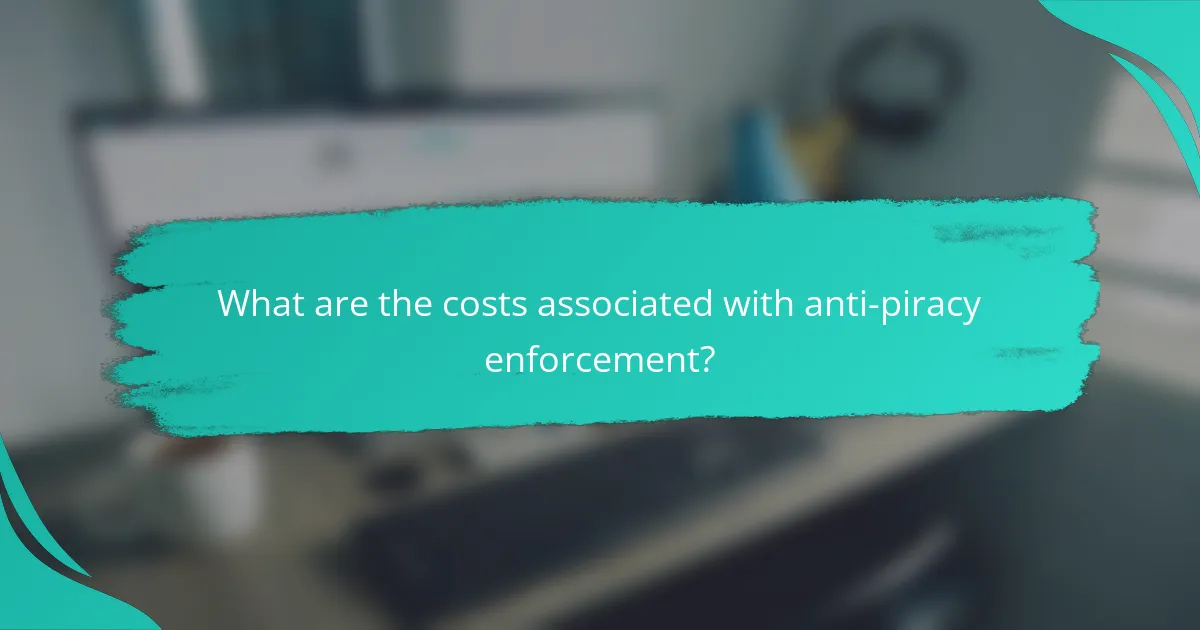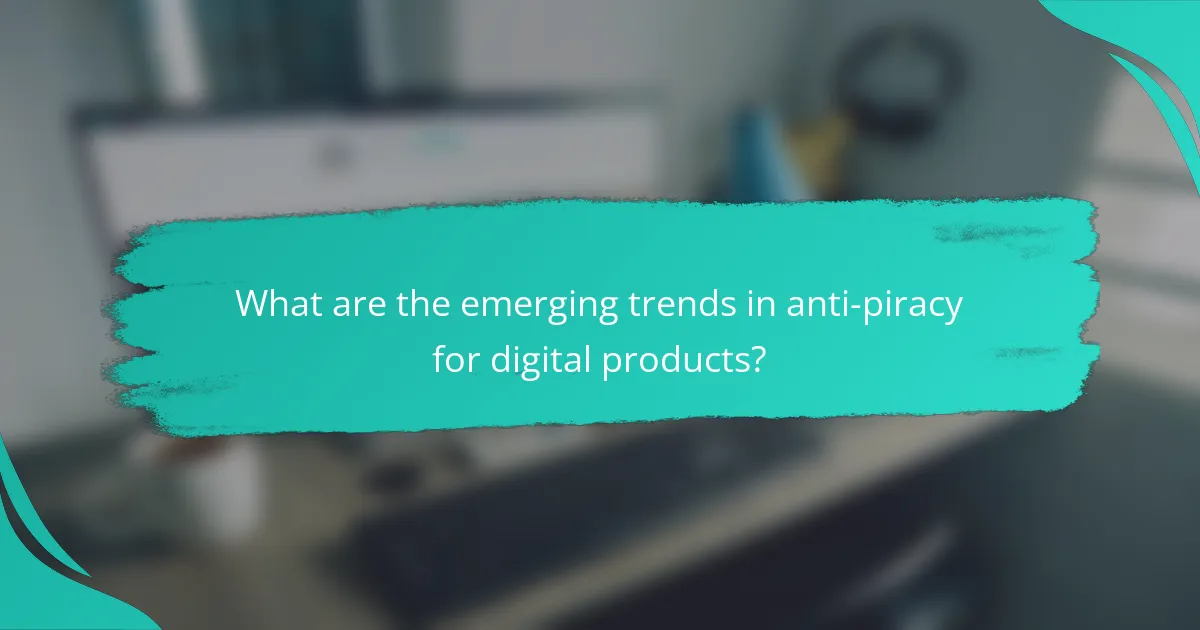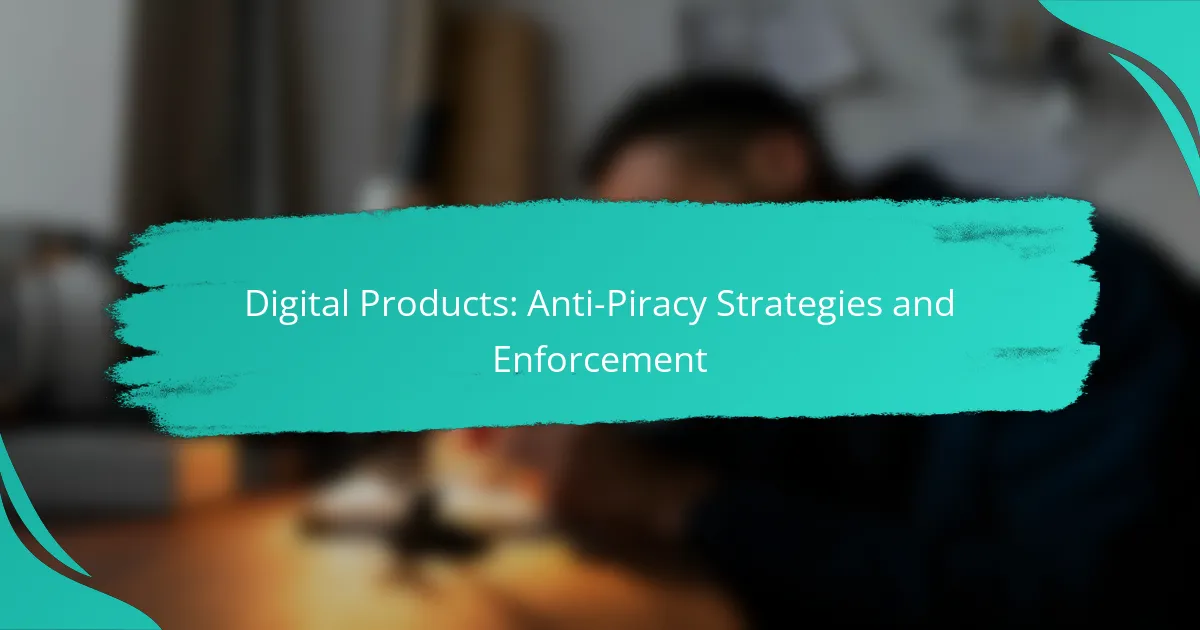In the digital landscape, effective anti-piracy strategies are essential for protecting intellectual property rights and minimizing unauthorized distribution of digital products. By combining technological measures, legal frameworks, and proactive monitoring, creators can enforce these strategies to safeguard their work. While the costs of enforcement can be significant, investing in automated systems and innovative technologies can greatly enhance protection against piracy.

What are effective anti-piracy strategies for digital products in Canada?
Effective anti-piracy strategies for digital products in Canada include a combination of technological measures, legal frameworks, and proactive monitoring. These strategies aim to protect intellectual property rights and minimize unauthorized distribution.
Digital Rights Management (DRM)
Digital Rights Management (DRM) refers to technologies that control how digital content is used and distributed. In Canada, DRM can restrict copying, sharing, and accessing digital products, ensuring that only authorized users can utilize the content. Common DRM solutions include encryption and license verification systems.
While DRM can effectively deter piracy, it may also frustrate legitimate users if access is overly restricted. Balancing user experience with protection is crucial when implementing DRM solutions.
Watermarking techniques
Watermarking involves embedding identifiable information into digital products, which can help trace unauthorized copies back to the source. In Canada, visible or invisible watermarks can deter piracy by making it clear that the content is protected and can be tracked.
Watermarks can be particularly useful for video and audio content, as they can be designed to be difficult to remove. However, they should be subtle enough not to detract from the user experience.
License agreements
License agreements outline the terms under which digital products can be used, shared, or distributed. In Canada, clear and enforceable license agreements can help protect intellectual property by specifying the rights and responsibilities of users.
Including clauses that address unauthorized use and the consequences of infringement can strengthen these agreements. Regularly updating license terms to reflect changes in technology and user behavior is also advisable.
Content monitoring services
Content monitoring services track the distribution of digital products across various platforms to identify unauthorized use. In Canada, these services can alert creators to potential piracy, allowing for swift action against infringers.
Utilizing automated tools that scan websites and social media for unauthorized copies can save time and resources. Regular monitoring can help maintain the integrity of digital products and protect revenue streams.
Legal action against infringers
Taking legal action against infringers is a critical component of an effective anti-piracy strategy in Canada. This may involve sending cease-and-desist letters or pursuing litigation against individuals or entities that violate copyright laws.
Understanding the legal framework surrounding copyright in Canada, including the Copyright Act, is essential for enforcing rights effectively. Consulting with legal professionals can help ensure that actions taken are appropriate and enforceable.

How can digital product creators enforce anti-piracy measures?
Digital product creators can enforce anti-piracy measures through a combination of technological solutions and legal strategies. Implementing automated systems and utilizing innovative technologies can significantly reduce unauthorized distribution and protect intellectual property.
Implementing automated takedown notices
Automated takedown notices are a proactive approach to combat piracy. By using services that monitor online platforms for unauthorized copies of digital products, creators can quickly issue takedown requests to websites hosting pirated content.
Key steps include setting up monitoring tools that scan for infringements and establishing a streamlined process for sending notices. Creators should ensure compliance with the Digital Millennium Copyright Act (DMCA) or equivalent regulations in their country to enhance the effectiveness of their takedown efforts.
Common pitfalls include failing to monitor all potential platforms and not keeping records of takedown requests. Regularly reviewing and updating the monitoring strategy can help maintain effectiveness.
Utilizing blockchain for ownership verification
Blockchain technology offers a robust method for verifying ownership of digital products. By registering digital assets on a blockchain, creators can provide irrefutable proof of ownership and authenticity, making it difficult for pirates to claim rights over the content.
To implement this, creators should consider using platforms that support digital asset registration on the blockchain. This can involve a one-time setup cost but can save significant resources in the long run by reducing piracy and enhancing trust with consumers.
However, creators must be aware of the varying regulations surrounding blockchain technology in different jurisdictions. Staying informed about local laws and best practices will ensure compliance and maximize the benefits of this technology.

What are the costs associated with anti-piracy enforcement?
The costs associated with anti-piracy enforcement can be significant and vary based on the strategies employed. Key expenses include legal fees, technology investments, and ongoing monitoring efforts to protect digital products from unauthorized use.
Legal fees for copyright infringement cases
Legal fees for copyright infringement cases can quickly accumulate, especially if litigation is involved. Costs may range from a few thousand to tens of thousands of dollars, depending on the complexity of the case and the jurisdiction.
Engaging experienced intellectual property attorneys is crucial, as they can navigate the legal landscape effectively. However, businesses should be mindful of the potential for escalating costs if cases go to trial.
Investment in technology solutions
Investing in technology solutions is essential for effective anti-piracy enforcement. This can include software for digital rights management (DRM), watermarking, and anti-counterfeiting measures, with costs often ranging from hundreds to thousands of dollars annually.
Choosing the right technology depends on the type of digital product and the specific threats faced. Businesses should evaluate options that provide strong protection while being cost-effective, ensuring a balance between security and budget.
Ongoing monitoring expenses
Ongoing monitoring expenses are necessary to detect and address piracy in real-time. This can involve subscription services or in-house teams dedicated to tracking unauthorized distribution, with costs typically ranging from a few hundred to several thousand dollars per month.
Regular monitoring helps identify new piracy trends and enables prompt action, reducing potential revenue loss. Businesses should consider investing in automated tools that can streamline this process and provide comprehensive coverage.

What role do government regulations play in anti-piracy?
Government regulations are crucial in anti-piracy efforts as they establish legal frameworks that protect intellectual property rights. These regulations help deter piracy by imposing penalties and providing mechanisms for enforcement, thus supporting creators and businesses in safeguarding their digital products.
Copyright Act in Canada
The Copyright Act in Canada provides the legal foundation for protecting original works, including digital products. It grants creators exclusive rights to reproduce, distribute, and publicly perform their works, which helps combat piracy by allowing legal action against infringers.
Under this act, penalties for copyright infringement can include significant fines and, in some cases, imprisonment. Businesses and creators should register their works to enhance protection and facilitate enforcement actions against piracy.
International treaties and agreements
International treaties and agreements, such as the Berne Convention and the Agreement on Trade-Related Aspects of Intellectual Property Rights (TRIPS), play a vital role in anti-piracy efforts across borders. These agreements set minimum standards for copyright protection and enforcement, encouraging cooperation among countries to combat piracy.
Countries that are signatories to these treaties are obligated to implement laws that protect intellectual property rights. This global framework helps creators pursue legal action in multiple jurisdictions, making it more challenging for pirates to operate without consequences.

How can digital product companies assess their vulnerability to piracy?
Digital product companies can assess their vulnerability to piracy by evaluating their current security measures and identifying potential weaknesses. This involves understanding the types of products offered, the target audience, and the methods used by pirates to exploit these products.
Conducting risk assessments
Conducting risk assessments involves systematically identifying and evaluating the risks associated with digital products. Companies should examine factors such as the product’s value, the potential impact of piracy, and existing security protocols.
Key steps include mapping out all digital assets, assessing their exposure to piracy, and determining the likelihood of various piracy methods being employed. Regular assessments can help companies stay ahead of emerging threats.
Analyzing competitor strategies
Analyzing competitor strategies provides insights into how similar companies protect their digital products from piracy. By studying competitors, companies can identify effective anti-piracy measures and potential gaps in their own strategies.
Look for common practices such as digital rights management (DRM), watermarking, and user authentication methods. Understanding what works for others can guide companies in adopting or adapting these strategies to enhance their own defenses.

What are the emerging trends in anti-piracy for digital products?
Emerging trends in anti-piracy for digital products focus on advanced technologies and collaborative efforts to combat unauthorized distribution. Key strategies include leveraging artificial intelligence, enhancing user authentication, and fostering industry partnerships to improve enforcement.
AI-driven content protection
AI-driven content protection utilizes machine learning algorithms to identify and mitigate piracy threats in real-time. These systems can analyze vast amounts of data to detect unauthorized copies of digital products across various platforms, significantly improving response times compared to traditional methods.
Implementing AI solutions often involves integrating automated monitoring tools that scan websites, social media, and file-sharing networks for infringing content. Businesses should consider the balance between the cost of these technologies and the potential revenue lost to piracy, as effective AI systems can reduce unauthorized access by significant margins.
Common pitfalls include relying solely on automated systems without human oversight, which can lead to false positives or negatives. Companies should regularly update their AI models and combine them with human expertise to ensure a comprehensive approach to content protection.
